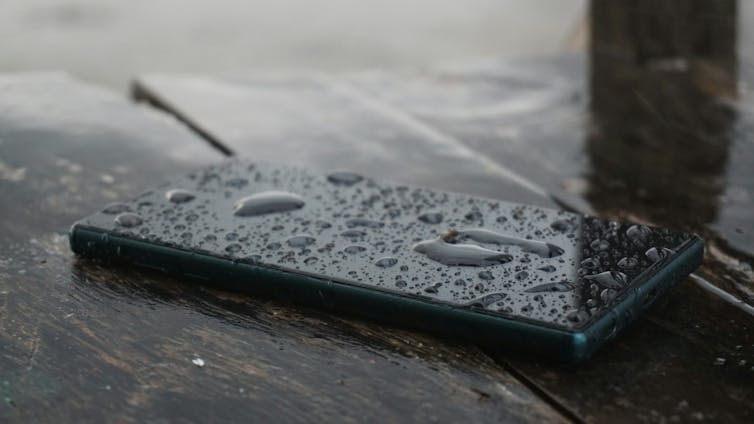
By Rachel Plotnick*
Nearly everyone has encountered the unthinkable: Your smartphone landed in the toilet. Or you forgot to take off your smartwatch before jumping into the pool. Or maybe you meant to take those earbuds out of your pocket before washing the laundry. What now?
Internet forums are chock-full of advice to dry out that drenched device, but problematic myths about liquid protection and repair make it hard for consumers to separate fact from fiction.
I’m a researcher who studies how technologies play a part in people’s everyday practices and experiences. My new book, “License to Spill: Where Dry Devices Meet Liquid Lives,” explores the wet-dry boundary in how people perceive and treat their electronic devices.
Here are five common myths about getting devices wet:
Myth 1: My device turned back on! It’s fine
While it’s a relief to see your technology rise from the dead, what you can’t see are subtle processes occurring inside, like corrosion. The breakdown of your device’s metal parts due to moisture often happens over time, in a period that can take place days, weeks or months after the offending incident.
That’s why even humidity from moist climates or your steamy shower can make a long-term impact, despite the fact that everything booted up right away after a splash or dunk.
Myth 2: My ‘waterproof’ device can tolerate any kind of wetness
The term “waterproof” is a controversial one – so controversial, in fact, that the Federal Trade Commission has strict rules about using the term in advertising, once even banning it from ad copy selling wristwatches.
Given the vagueness of the term, it’s better to examine different water resistance standards, such as ingress protection, or IP, ratings and MIL-SPEC, or ISO in the case of watches, and to read the fine print about what those standards actually cover.
Myth 3: My device has a great IP rating, so it’s been tested under real-world conditions
Companies often advertise IP ratings as a way to entice consumers to purchase their products, but it’s important to know that these ratings are based on contact with fresh water. If you’re worried about Jacuzzi suds or that tipped-over can of beer, there’s no guarantee that a manufacturer has tested your device in these – often sticky – situations, and an IP rating won’t account for them.
Myth 4: I’ve got some rice in the kitchen. I can fix this myself!
It’s natural to panic and seek out the quickest household solution when a spill or dunk happens, and a cup of rice is still a commonly sought-out option.
However, the rice hack doesn’t work very well, and rice particles can enter the device to cause even further damage. Aside from bringing your device to a professional repairer, you’re better off immediately powering down your product, removing its battery and plug if you can, and letting all the components dry over a day or two.
Myth 5: Well, this device is broken, but I’ve got a warranty to replace it
While you’re pulling your product from its watery grave, you might find relief in the fact that it came with a warranty. Not so fast.
Most traditional consumer technology limited warranties don’t cover liquid damage. These days, you usually need to purchase an add-on warranty, often called Accidental Damage from Handling. Beware, though: Even those policies may limit how many wetness “incidents” or “events” you’re allowed per year.
Air flow is the best way to dry a device that’s taken a dunk. Don’t expose your device directly to rice, cat litter or other particles.
Keeping it realistic
Water resistance features on devices like laptops, tablets, smartphones and smartwatches have recently improved, but the deck is still often stacked against consumers who must wade through the hype of advertising claims, mystifying classification systems and penalising policies.
That’s why it’s critical for manufacturers to think carefully and ethically about how their products are designed, marketed and serviced. In terms of design, water resistance is no longer a niche feature meant solely for industrial workers or outdoor adventurers. While it’s unrealistic to expect a device that’s designed to resist every hazard, it’s also unreasonable to ask consumers to tiptoe around the products that provide them with access to critical resources and social support.
It’s important for manufacturers to avoid promising consumers the Moon. Samsung Australia, for instance, paid AU$14 million in penalties for exaggerating its phones’ protection for swimming. It’s certainly fun to watch commercials with Lil Wayne spraying a smartphone with champagne or see him dunk it in a fish tank, but if manufacturers are advising against these practices, then they shouldn’t be romanticising them.
Sure, it’s probably common sense that your phone shouldn’t take a bath in champagne. Yet life is constantly happening around – and with – our devices, from the shower and the kitchen to the gym and the beach. This means that fairer policies around repair, like those promoted by the right-to-repair movement, and warranties should stop treating consumers like they’re “bad” users.
After all, we’re each just one splash away from crying over spilled milk.![]()
*Rachel Plotnick, Associate Professor of Cinema and Media Studies, Indiana University.
This article is republished from The Conversation under a Creative Commons license. Read the original article.
6 Comments
I find it a bit of a shame that there is no good advice given on what to do when one's smartphone has been dropped in water for a short period of time.
A friend's latest IPhone was recently dropped in a shallow pool in Bali for less than 20 seconds, and we were unable to ever turn it back on. What should we have done ?
Looking at what Apple says, you should take it in for service. This page is for Mac computers, but I would imagine it applies to iPhones as well. There are I believe limitations as to liquid damage coverage, even with AppleCare, so it'd be worth looking at the first as you might have to pay for the service.
Thanks Juha
Friends Android suffered same fate on holiday. Was wet, dead and wouldn't charge as result. Solution was a wireless charger that saved the holiday and over time the plug in started to work again.
Put the phone in rice and leave it overnight, trust me.
Take the covers off if you can, tilt device so water can drain down, blow ambient to <40 degree centigrade temperature air using a fan at it for at least a day or two. Test. This should work if the water hasn't gone inside components and physically and chemically altered them.

We welcome your comments below. If you are not already registered, please register to comment
Remember we welcome robust, respectful and insightful debate. We don't welcome abusive or defamatory comments and will de-register those repeatedly making such comments. Our current comment policy is here.